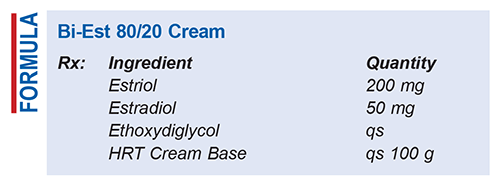US Pharm. 2023;48(9):59-60.

Method of Preparation: Calculate the required quantity of each ingredient for the total amount to be prepared. Accurately weigh the estriol (E3) and estradiol (E2). Combine the E3, E2, and a few drops of ethoxydiglycol; then mix, dispersing evenly, until a smooth paste is formed. Geometrically, incorporate the HRT Cream Base to final weight and mix to form a homogenous cream. Package and label.
Use: This formulation has been used in hormone replacement therapy (HRT) to alleviate menopausal symptoms such as hot flashes, vaginal dryness, and mood fluctuations.
Packaging: Package in a tight, light-resistant container.
Labeling: Keep out of reach of children. Use only as directed. Store in a cool, dry place. Avoid direct sunlight. Discard after _____ [time period].1
Stability: The USP default beyond-use date for this preparation is up to 180 days.2
Quality Control: Weight/volume, pH, specific gravity, active drug assay, color, rheologic properties/pourability, physical observation, and physical stability (discoloration, foreign materials, gas formation, mold growth) are all examples of quality-control assessments).3
Discussion: Bi-Est contains two bioidentical estrogens: E3 and E2. Its broad range of delivery methods, such as capsules, troches, creams, and suppositories, enables it to be customized according to patient preference and therapeutic requirements. The most common Bi-Est dosage strength is an 80:20 ratio (E3 80%, E2 20%). Adverse effects associated with this bioidentical hormone cream vary based on the formulation and dosage. Common adverse effects of Bi-Est include fatigue, skin changes, headache, breast tenderness, and nausea.2,4
E3 (C18H24O3, MW 288.4) is a natural estrogen and a metabolite of E2. Although on its own it lacks sufficient potency to alleviate menopausal symptoms, the combination of E3 with E2 enhances therapeutic efficacy. E3 occurs as a crystalline powder that has limited solubility in water but is soluble in alcohol and vegetable oils. E3’s interaction with E2 and estrone involves reversible oxidation, and its systemic bioavailability via vaginal administration is superior to that for oral delivery.5,6
E2 (oestradiol, beta-estradiol, C18H24O2, MW 272.38) occurs as white or creamy-white hygroscopic crystals or as a crystalline powder. It has limited solubility in aqueous environments, and it is soluble in alcohol and sparingly soluble in vegetable oils. E2 should be stored in an airtight container at controlled ambient temperature and safeguarded against exposure to light. E2 is commercially available as oral tablets, injections, vaginal rings, and other forms. On its own, E2 has low oral bioavailability. Transdermal E2 avoids first-pass metabolic effects that reduce bioavailability.5
Ethoxydiglycol (CH2OHCH2OCH2CH2OC2H5, C6H14O3, MW 134.20) is also known as diethylene glycol monoethyl ether, diethylene glycol ethyl ether, transcutol, and carbitol. It is a colorless liquid with a mild odor, and it has a density of 1.0272. Ethoxydiglycol is a hygroscopic organic solvent that can be mixed with water and other organic solvents. As a solvent, ethoxydiglycol improves the solubility and permeability of active ingredients, and it is also used as a solubilizer and a cosurfactant. Ethoxydiglycol is nonirritating and nonpenetrating when applied to human skin.7
HRT Cream Base is a smooth, odorless, and white to off-white cream. It is a vanishing oil-in-water emulsion that has moisturizing and penetration-enhancing capabilities. HRT Cream Base has a pH range of 5.60 to 7.25 and a specific gravity of 0.95 to 1.10.8 It has minimal solubility in cold water. HRT Cream Base is free of alcohol, petrolatum, and oil. Beyond its role as a hormone carrier, HRT Cream Base is extremely well suited for dermatologic applications, and its absorbency complements lipophilic drugs.
REFERENCES
1. U.S. Pharmacopeia/National Formulary [current revision]. Rockville, MD: U.S. Pharmacopeial Convention, Inc; September 2022.
2. Boothby LA, Doering PL, Kipersztok S. Bioidentical hormone therapy: a review. Menopause. 2004;11:356-367.
3. Allen LV Jr. Standard operating procedure for performing physical quality assessment of oral and topical liquids. IJPC. 1999;3:146-147.
4. Compounded bioidentical hormone preparations. In: Jackson LM, Parker RM, Mattison DR, eds. The Clinical Utility of Compounded Bioidentical Hormone Therapy: A Review of Safety, Effectiveness, and Use. Washington, DC: National Academies Press; 2020.
5. Lacy C, Armstrong LL, Ingrim NB, Lance LL. Drug Information Handbook. 4th ed. Hudson, OH: Lexi-Comp, Inc; 1996:445-447.
6. Reynolds JE, ed. Martindale: The Extra Pharmacopoeia. 30th ed. London, England: Pharmaceutical Press; 1993:1192.
7. Ash M, Ash I. Handbook of Pharmaceutical Additives. Brookfield, VT: Gower Publishing Ltd; 1995:484.
8. HRT Cream Base product information. Plattsburgh, NY: Medisca.
The content contained in this article is for informational purposes only. The content is not intended to be a substitute for professional advice. Reliance on any information provided in this article is solely at your own risk.
To comment on this article, contact rdavidson@uspharmacist.com.





